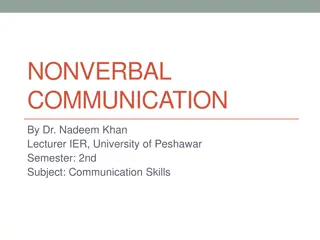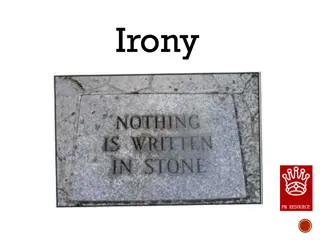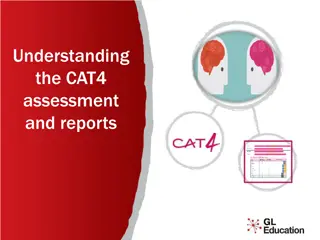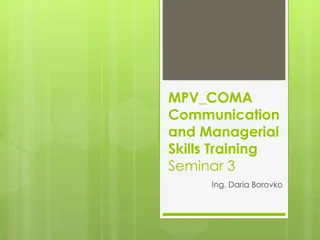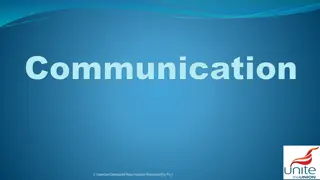Mastering Communication Skills: Essential Techniques
Enhance your communication skills through understanding types of communication, practicing the POP technique, and using verbal and nonverbal cues effectively. Improve your ability to convey messages clearly and make a positive impact.
1 views • 22 slides
Mastering Effective Communication in the Workplace
Explore the significance of effective communication, various communication preferences, and strategies to enhance communication dynamics. Dive into non-verbal cues, listening skills, and overcoming barriers to communication. Understand the impact of different communication channels and how to engage
12 views • 40 slides
Understanding Communication Styles and Advantages of Written Communication
Communication is the process of sharing information through various mediums like verbal, non-verbal, written, and visual. Understanding the communication cycle and different styles - verbal, non-verbal, visual, and written - is crucial for effective communication. Written communication offers advant
9 views • 22 slides
Effective Communication Skills for Improved Interaction
Enhance your communication skills with tips like being an attentive listener, using clear language, leveraging non-verbal cues, and showing empathy. Learn how stress and anxiety can hinder effective communication and the importance of feedback. Developed by K. Syed Abthaheer, this resource emphasize
0 views • 10 slides
Understanding Verbal Prescriptions in Pharmacy Practice
This comprehensive guide provides insights into obtaining verbal prescriptions, necessary information in a verbal prescription, types of written verbal prescriptions, acceptable sources for verbal prescriptions, authorized personnel to accept verbal prescriptions, laws regarding interns and verbal p
0 views • 18 slides
Understanding Communication and Sign Language
Communication is the vital process of exchanging information, ideas, and emotions through various channels such as speech, signals, and writing. This includes verbal and non-verbal communication, where sign language plays a crucial role. Effective communication depends on the sender, message, channe
1 views • 31 slides
Understanding Communication Skills and Types
Communication is the exchange of information through various mediums like speaking and writing. It can be verbal or non-verbal. Verbal communication involves oral and written forms, while non-verbal communication includes body language and appearance. Each type has its own advantages and drawbacks,
1 views • 13 slides
Understanding Verbal and Non-Verbal Tests
Verbal and non-verbal tests serve different purposes in assessing intelligence and skills. Non-verbal tests utilize images and diagrams to measure reasoning abilities without requiring reading or writing. Verbal tests, on the other hand, assess language-based skills through reading, writing, or oral
0 views • 14 slides
Effective Communication Skills for Healthcare Professionals
Enhance your communication skills with the Accelerated Preceptorship Communication Session by Desiree Cox. Learn the importance of effective communication, different communication preferences, communication dynamics, non-verbal communication, listening skills, and more. Understand the communication
2 views • 28 slides
Understanding Modes of Communication and Verbal Messages
Communication occurs through verbal and nonverbal modes, with messages having denotative and connotative meanings. Verbal messages vary in directness, affecting the effectiveness of communication. Indirect messages offer advantages such as politeness and avoiding offense, but can also lead to misund
0 views • 64 slides
Understanding the Importance of Nonverbal Communication in Communication Skills
Nonverbal communication plays a crucial role in conveying messages and signals through platforms like eye contact, facial expressions, gestures, posture, and spatial distance. It includes appearance, body language, silence, time, and space. This form of communication can significantly impact the rec
0 views • 16 slides
Understanding Irony in Verbal, Dramatic, and Situational Contexts
Explore the nuances of verbal, dramatic, and situational irony through examples and explanations. Verbal irony involves saying something different from what is meant, often using humor like puns. Dramatic irony occurs when the audience knows something the characters don't, creating suspense. Situati
0 views • 12 slides
Understanding the CAT4 Assessment and Reports
CAT4, the Cognitive Abilities Test Fourth Edition, assesses students' abilities in verbal, quantitative, non-verbal, and spatial reasoning. It distinguishes between ability and attainment testing and is used to identify academic potential, understand student thinking, determine support needs, highli
1 views • 15 slides
The Impact of Changing Communication Technologies on Inter-generational Interaction
The evolution of communication technologies has influenced intra-generational and cross-generational interactions. With increased use of mobile devices, younger generations tend to multitask and may not always focus on face-to-face conversations, impacting non-verbal cues. Social norms have shifted
0 views • 6 slides
Enhancing Communication and Facilitation Skills in Training
Explore the vital aspects of communication and facilitation skills in training sessions. Learn to effectively convey information, identify verbal and non-verbal cues, and foster interpersonal communication. Discover the role of a training facilitator in maximizing learning outcomes through tailored
0 views • 13 slides
Enhancing Social Skills and Communication Abilities
This presentation focuses on improving social skills and communication, including non-verbal cues, body language, and eye contact. It highlights the importance of understanding social situations and provides insights on navigating interactions effectively. The session offers practical tips for indiv
0 views • 35 slides
Understanding Micromessaging: Hidden Impact of Subtle Behaviors
Micromessaging refers to the subtle, semi-conscious messages we send through our behaviors, both verbal and physical, that influence our interactions with others. These messages, categorized as micro-affirmations and micro-inequities, can have a significant impact on individuals. The concept delves
1 views • 17 slides
Building the Posner Cueing Task in PsychoPy
Learn how to create the Posner cueing task in PsychoPy for psychological research. The task involves presenting cues, targets, and response options in a precise sequence to study attentional processes. By following detailed instructions, you can build the task with fixation points, cues, targets, an
0 views • 8 slides
Handy Assistant's Guide for Effective Communication
Enhance your communication skills with the help of this comprehensive guide. Learn how to listen actively, express yourself clearly, and build strong relationships. Overcome challenges, and become a better communicator in various settings. Gain insights on non-verbal cues, feedback, and managing con
0 views • 8 slides
Importance of Communication Skills in Understanding Interlocutors
Understanding the significance of communication skills is crucial in establishing connections and adapting to diverse scenarios. Proficient communication involves analyzing non-verbal cues, such as tone, gestures, and eye contact, to effectively relate to others within the initial moments of interac
0 views • 35 slides
Variety of Verbal Analogy Questions and Practice Sets
Explore a variety of verbal analogy questions and practice sets focusing on different types of relationships between words. From number series to verbal classification, essential parts, analogies, artificial language, and more, these exercises aim to enhance your verbal reasoning skills and logic. L
0 views • 20 slides
Understanding Semantic Effects in Verbal Short-term Memory
Investigating the impact of semantic knowledge and similarity on verbal short-term memory, this study delves into how imageability of words influences recall. Key findings highlight the influence of semantic relatedness and the imageability effect on memory retention, shedding light on the mechanism
0 views • 47 slides
Enhancing Communication Through Reflective Listening Techniques
The Reflective Listening process fosters effective communication by showing understanding, providing feedback, and guiding emotional expression. Skills like attending and reflective skills, as well as non-verbal cues like eye contact and gestures, play a crucial role. Silence can also be a powerful
0 views • 11 slides
Understanding Verbal Irony and Tone Through Examples
Verbal irony is the expression of words conveying the opposite of their literal meaning. It is not the same as lying and is used to emphasize a point. Tone plays a crucial role in conveying irony, as it can affect how the message is perceived. Sarcasm, though related, has a negative agenda of mockin
0 views • 7 slides
Effective Communication Strategies for Respectful Interactions
Explore the importance of effective communication in respecting yourself and others. Learn about different communication styles, speaking and listening skills, and active listening techniques to enhance your interactions. Discover how to use 'I' messages, avoid mixed messages, and practice empathy f
0 views • 35 slides
Enhancing Communication Skills Through Mindful Listening
Cultivating mindfulness in conversations allows us to notice subtle cues, enabling deeper understanding and connection. By staying present and attuned to verbal and non-verbal signals, we can uncover underlying meanings and address sensitive topics effectively. Grounding exercises, pauses, and activ
0 views • 14 slides
Mastering High-Touch Relationships in the Digital Era
Discover effective communication strategies for maintaining high-touch relationships in today's high-tech world. Explore the importance of communication basics, decoding text talk, understanding verbal and nonverbal cues online, and knowing when to call instead of email or text. Learn how to craft r
0 views • 12 slides
Understanding Human Relations and Communication
Human relations pertain to relationships among individuals, whether formal or informal, emotional or unemotional. Effective communication involves conveying thoughts and understanding others. It includes verbal and nonverbal aspects, with nonverbal communication playing a significant role in message
0 views • 57 slides
Understanding Meaning in Cultural Contexts through Action
Explore the importance of context in understanding meaning in different cultures and situations, focusing on structures of expectation, frames, contextualization cues, situated inferences, pragmatic coherence, and the cooperative principle in communication. Gain insights into how language users inte
0 views • 8 slides
Staffordshire CUES Virtual Training Event Overview
Explore the highlights of the Staffordshire Covid-19 Urgent Eyecare Service (CUES) Virtual Training Event, featuring introductions, covered CCG areas, service fees, OCT assessments, and imaging procedures within CUES to enhance eyecare delivery. Learn about the key aspects discussed by experts and h
0 views • 58 slides
Mastering Nonverbal and Verbal Communication for Effective Leadership
Discover the crucial X and Y factors of nonverbal and verbal communication for leaders through active listening, message delivery, and nonverbal cues. Explore how poor communication leads to stress and learn techniques like reflective styles, Socratic questioning, and giving concise messages. Enhanc
0 views • 30 slides
Effective Sermon Delivery Techniques for Engaging Presentations
Enhance your sermon delivery skills with insights from Dr. Rick Griffith and Ken Davis on the importance of non-verbal communication, proper gestures, audience-oriented movements, and dressing appropriately. Learn how to communicate effectively through both verbal and non-verbal cues for impactful p
0 views • 26 slides
Discrimination Training and Reweighting of Interaural Cues
This project focuses on discrimination training and reweighting of interaural level vs. time difference cues in normal-hearing listeners for sound localization. It explores the dominant cues at different frequencies and factors influencing binaural cue weighting. The study aims to reweight these cue
1 views • 15 slides
Mastering Non-Verbal Communication in Managerial Skills Training
Explore the intricacies of non-verbal communication, including body language, tone of voice, and facial expressions, in the context of managerial skills training. Learn to detect signs of lying, evaluate interest and criticism, and recognize attitudes such as boredom and defensiveness. Enhance your
0 views • 34 slides
Effective Communication in Nursing: Key Concepts and Phases
Communication in nursing plays a vital role in establishing relationships, expressing empathy, and providing care information. This article explores the purposes and types of communication in nursing, emphasizing the significance of verbal and non-verbal cues. Additionally, it delves into the phases
0 views • 16 slides
Effective Pronunciation Activities for EAP Learners
Explore innovative pronunciation activities for EAP learners focusing on diphthongs and nuclear stress. Discover strategies to contrast sounds across languages, provide visual cues, and integrate nuclear stress training into assessment preparation. Utilize methods like correction through non-verbal
0 views • 8 slides
Exploring Effective Communication in Union Environments
In this session, we delve into effective communication within union settings, identifying and removing barriers to successful communication. We discuss the importance of non-verbal cues, explore common understanding, and examine communication models like Shannon & Weaver. Key skills such as active l
0 views • 23 slides
Understanding Verbal and Non-Verbal Communication
Verbal communication involves both speaking and listening, with listening being equally essential. It can be classified into sympathetic and empathetic listening, each serving different purposes in understanding others' feelings. Sympathetic listening involves sharing emotions, while empathetic list
0 views • 52 slides
Mastering Effective Interpersonal Communication: Key Principles and Strategies
Effective interpersonal communication is essential for human existence, impacting our happiness and relationships. This entails clear encoding, minimal noise, and strategic message delivery. Communicators must possess expertise, charisma, and sincerity. Messages should appeal to logic and evoke emot
0 views • 20 slides
Analysis of Discourse Styles in Therapeutic Conversations by Labov and Fanshel
Labov and Fanshel's non-critical approach to discourse analysis focuses on the heterogeneity of conversation styles, emphasizing shifts between frames and the importance of paralinguistic cues in therapeutic discourse. They identify different styles associated with various frames, such as interview
0 views • 14 slides










